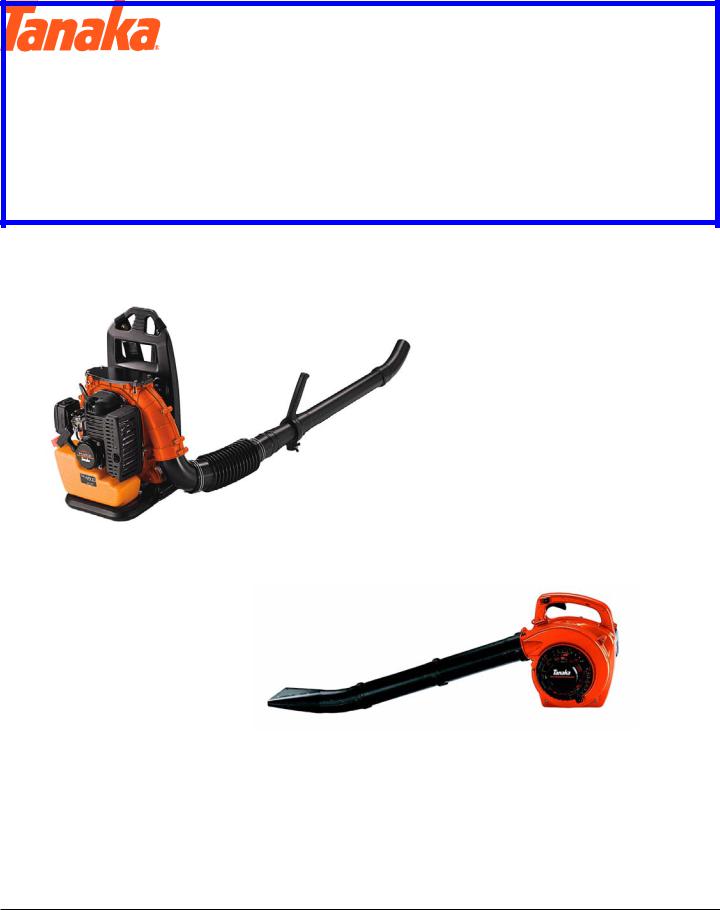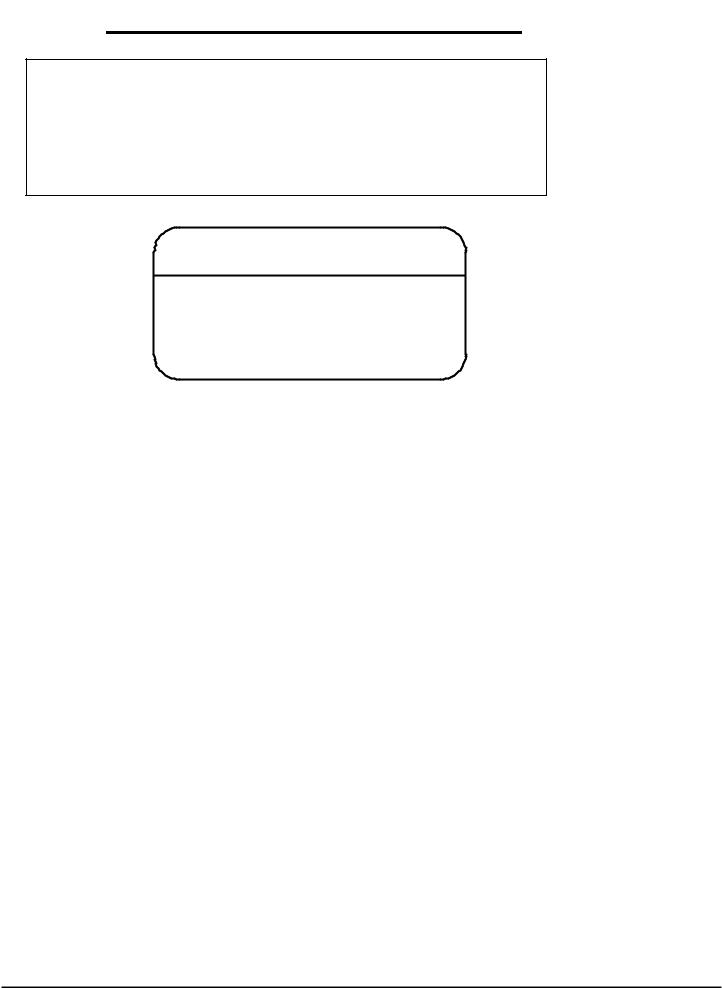Tanaka TBL-505, TBL-4600, TBL-4610, THB-2510, THB-2500 User Manual

|
Owner’s Manual |
|
|
|
|
Model Numbers: |
P/N 12626 |
THB-2500,THB-2510, |
Date 08-10-01 |
|
|
TBL-4600,TBL-4610,TBL-505 |
|
BLOWERS |
|
TBL-4600
THB-2510
Supplier To The Outdoor Power Equipment Industry
ISM, Inc. • 1028 4th Street SW • Auburn, WA 98001 • Phone: (253) 333-1200 • Fax: (253) 333-1212
www.tanakapowerequipment.com |
custsvc@tanaka-ism.com |

THB-2500/THB-2510/TBL-4600/4610,TBL-505 Owner’s Manual
Before using this unit:
•Read the operator’s manual carefully.
•Check that the blower is correctly assembled and adjusted.
•Start the unit and check the carburetor adjustment. See “Maintenance”.
 WARNING
WARNING
The engine exhaust from this product contains chemicals known to the State of California to cause cancer, birth defects and other reproductive harm.
Always wear eye, head and ear protectors when using this unit.
Read, understand and follow all warnings and instructions in this manual and on the unit.
It is important that you read, fully understand and observe the following safety precautions and warnings. Careless or improper use of the unit may cause serious or fatal injury.
Explains choke position. Upper sign indicates choke closed and the lower fully open.
WARNING DANGER
DANGER
Keep hands off from rotating fan. For vacuum, vacuum pipe and bag must be in place. For blower, dust cover must be securely installed.
www.tanakapowerequipment.com |
1 |
custsvc@tanaka-ism.com |

THB-2500/THB-2510/TBL-4600/4610,TBL-505 |
Owner’s Manual |
|
www.tanakapowerequipment.com |
2 |
custsvc@tanaka-ism.com |

THB-2500/THB-2510/TBL-4600/4610,TBL-505 |
Owner’s Manual |
|
2. Warnings and safety instructions.
Operator Safety
•IMPORTANT: A dust filter mask should be worn during operation.
•Always wear a safety face shield or goggles. Always wear heavy, long pants, boots and gloves. Do not wear loose clothing, jewelry, short pants, sandals or go barefoot. Secure hair so it is above shoulder length.
•Do not operate that tool when you are tired, ill or under the influence of alcohol, drugs or medication.
•Never let a child or inexperienced person operate the machine.
•Wear hearing protection.
•Never start or run the engine inside a closed room or building. Breathing exhaust fumes can kill.
•Keep handles free of oil and fuel.
•Keep hands away from moving part or heated area.
•Do not grab or hold the unit by the blow pipe.
•When the unit is turned off, make sure the engine has stopped before the unit is set down.
•When operation is prolonged, take a break from time to time so that you may avoid possible whitefinger disease which is caused by vibration.
Tool Safety
•Inspect the entire tool before each use. Replace damaged parts. Check for fuel leaks and make sure all fasteners are in place and securely fastened.
•Replace parts that are cracked, chipped or damaged in any way before using the tool.
•Make sure the safety guard is properly attached.
•Keep others away when making carburetor adjustments.
•Use only accessories as recommended for this tool by the manufacturer.
 WARNING!
WARNING!
Never modify the tool in any way. Do not use the tool for any job except that for which it is intended.
Fuel Safety
•Mix and pour fuel outdoors and where there are no sparks or flames.
•Use a container approved for fuel.
•Do not smoke or allow smoking near fuel or the tool or while using the tool.
•Wipe up all fuel spills before starting engine.
•Move at least 3 m (10 ft) away from fueling site before starting engine.
•Stop engine before removing fuel cap.
•Empty the fuel tank before storing the tool. It is recommended that the fuel be emptied after each use. If fuel is left in the tank, store so fuel will not leak.
•Store tool and fuel in area where fuel vapors cannot reach sparks or open flames from water heaters, electric motors or switches, furnaces, etc.
 WARNING!
WARNING!
Antivibration systems do not guarantee that you will not sustain whitefinger disease or carpal tunnel syndrome. Therefore, continual and regular users should monitor closely the condition of their hands and fingers. If any of the above symptoms appear, seek medical advice immediately.
Blowing Safety
•Operate power equipment only at reasonable hours-not early in the morning or late at night when people might be disturbed. Comply with times listed in local ordinances. Usual recommendations are 9:00 a.m. to 5:00 p.m., Monday through Saturday.
•Never direct discharge of air toward bystanders nor allow anyone near the area of operation. Use care in directing discharge to avoid glass enclosures, automobiles, etc.
•Stay alert for uneven sidewalks, holes in terrain or other unstable condition when using the tool.
•Take all possible precautions when leaving the tool unattended such as stopping the engine.
•Never operate the tool without guards, blow pipes or other protective device in place. (if so equipped.)
•Keep others including children, animals, bystanders and helpers outside the 15 m (50ft) hazard zone. Stop the engine immediately if you are approached.
•Always keep the engine on the right side of your body. (Hand held blower only)
•Keep firm footing and balance. Do not over-reach.
•Keep all parts of your body away from the muffler.
Maintenance Safety
•Maintain the tool according to recommended procedures.
•Disconnect the spark plug before performing maintenance except for carburetor adjustments.
•Keep others away when making carburetor adjustments.
•Use only genuine replacement parts as recommended by the manufacturer.
Transport and storage
•Carry the tool by hand with the engine stopped and the muffler away from your body.
•Allow the engine to cool, empty the fuel tank, and secure the tool before storing or transporting in a vehicle.
•Empty the fuel tank before storing the tool. It is recommended that the fuel be emptied after each use. If fuel is left in the tank, store so fuel will not leak.
•Store tool out of the reach of children.
•Clean the unit carefully and store it in a dry place.
•Make sure engine switch is off when transporting or storing.
If situations occur which are not covered in this manual, take care and have good judgment. Contact your dealer if you need assistance.
Pay special attention to statements preceded by the following words:
 WARNING!
WARNING!
Indicates a strong possibility of severe personal injury or loss of life, if instructions are not followed.
CAUTION!
Indicates a possibility of personal injury or equipment damage, if instructions are not followed.
NOTE!
Helpful information for correct function and use.
www.tanakapowerequipment.com |
3 |
custsvc@tanaka-ism.com |

THB-2500/THB-2510/TBL-4600/4610,TBL-505 Owner’s Manual
3. Assembly procedures.
Blow pipes to main body (Fig. 1-1) Inspect the main body and accessories, Connect straight pipe (1) and other pipe(s) securely. (See page 1)
Align groove (2) in straight pipe with projection (3) on blower housing (or another pipe) and slide the pipe onto the blower housing (or another pipe).
Rotate the pipe clockwise to lock it into place, then tighten the clamp band (if so equipped, THB-2510).
NOTE! (TBL-4600, optional)
•Connect flexible pipe (2) to main body with clamp (1). Finger-tighten the clamp.
•Connect swivel pipe (4) to flexible pipe with clamp (3).
•Install throttle grip (5) to swivel pipe so that the grip locates 2-3 cm away from projection (6) on swivel pipe.
•Finally, if direction of bent pipe does not match the direction of throttle grip, loosen knob (7) or wing bolt (8) (enclosed in vinyl bag) and swivel the grip to your comfort. (Fig. 1 - 1 B)
NOTE! (TBL-4600/4610/505, optional)
•Use flexible pipe with wire clamps.
•Install the pipe handle on swivel pipe or on straight pipe. Decide location and direction to your comfort.
(Fig. 1-2)
NOTE! (THB-2510, optional)
Vacuum attachment is offered as an optional kit, which converts the hand-held blower into a vacuum cleaner. For installation, see THV-200 vacuum manual.
www.tanakapowerequipment.com |
4 |
custsvc@tanaka-ism.com |
